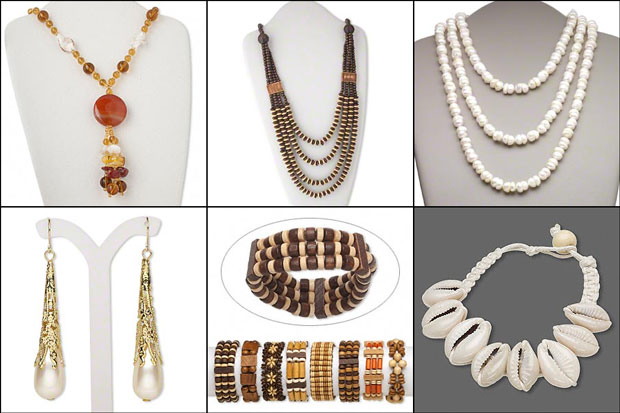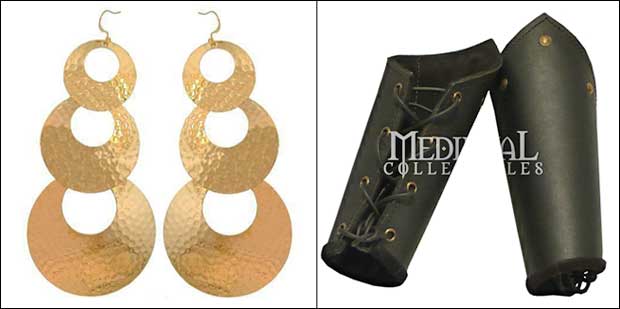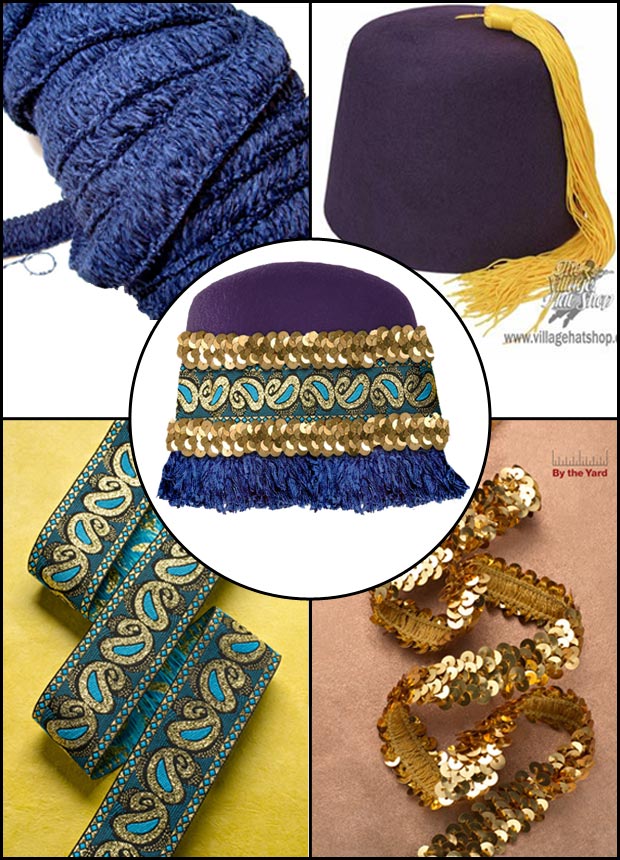Of all the great bird goddesses in world mythology, the Morrigan is surely one of the birdiest. This Irish goddess typically appears as a crow or raven hovering over the battlefield, feasting on the corpses of the slain. She’s a carrion bird, basically; the Celts, like their Germanic neighbors, saw these birds as she-demons or goddesses who conducted fallen warriors to the great beyond. Even when the Morrigan appears as a woman, blood and gore aren’t far away: her clothes are red, her eyes are red, her mouth is red. She stands in the ford of the river, washing the bloody clothes and armor of those about to die, up to her elbows in gore.
The Irish epics often describe the Morrigan as one of three sisters, all of whom are linked with battle and death. Sometimes the name “Morrigan” refers to one of them; sometimes it refers to the whole group. The screaming banshees of Irish legend are probably their folkloric descendants.
The Morrigan has a special connection with Halloween. According to Irish mythology, it was on Samhain that the Morrigan kept a tryst with the Dagda, the great father-god of the old Irish pantheon. Samhain became All Hallows Eve in Christian times, and ultimately our Halloween.
 For your own rendition of the Morrigan, we propose Iron Age Celtic dress combined with bird feathers and makeup—plus two fake birds to perch on your shoulders as your sisters. The items we suggest, from left to right:
For your own rendition of the Morrigan, we propose Iron Age Celtic dress combined with bird feathers and makeup—plus two fake birds to perch on your shoulders as your sisters. The items we suggest, from left to right:
1. Garnet red flannel flat sheet to use as an unsewn tunic. The oldest kind of Celtic tunic was remarkably similar to the classic Doric chiton of Greece. All you need is a bed sheet and some safety pins; we give you instructions below on how to pin it together. You just need a flat sheet, not the whole set, though it can be difficult to find them sold separately.
2. Wool throw in Royal Stewart tartan to use as a cloak. This beautiful fringed throw isn’t at all expensive—only about 60 bucks. But for an even thriftier alternative, just go to the fabric store and get two yards of Royal Stewart fleece or flannel. (Don’t worry about the fact that this pattern is named after the Stewarts. Gaels and other Celts have been enjoying plaid since the Iron Age, long before the 19th century fad for assigning particular tartans to Scottish clans.)
3. Celtic circlet. Another Etsy shop that also carries a wide range of circlets is Moon Maiden Jewelry.
4. Two artificial ravens (8.5 inches long). These are much smaller than real ravens, but that makes them easier to attach to your costume. Use some Velcro on the plaid cloak to keep the birds perched on your shoulders. Check out Factory Direct Crafts for ravens in other sizes.
5. Mehron makeup kit for eyes plus optional red body paint for hands. Joyce Sola of CandyLoveArt did an Angry Birds makeup tutorial that shows how to do the eyes: video and blog post. You don’t absolutely have to paint your hands red, but it does heighten the eerieness factor.
6. Feather choker: one yard of 2-inch wide black velvet ribbon and about one yard of 6-inch wide black hackle feather trim (cut into two lengths). This is extremely easy to rig up: just tape the pre-strung hackle feathers inside the wide velvet ribbon. Tie the loose ends of the ribbon in a knot at the back of your neck.
Choker diagram:
How to make a chiton: The ancient Doric chiton was just a single rectangle of fabric folded around the body. This became the jeans-and-T-shirt of the classical world, and was worn from northern Europe to the Mediterranean. In Celtic contexts it’s often referred to as the “bog dress,” because Iron Age versions of it have been recovered from peat bogs. All you need is a flat sheet, some safety pins, and a belt or cord:
Main illustration credits: The large watercolor in the center of our illustration is by Claudine and Roland Sabatier. It’s a banshee from The Great Encyclopedia of Faeries by Pierre Dubois, published in 1996. The painting in the upper right corner is by Brigid Ashwood. The painting below that is by Laura Cameron, and you can buy a print of it right there in her shop.
Catherine the Great (1729-1796) was probably the best tsar Russia ever had. She arrived in the country as a teenaged German bride, and eventually took the throne in a coup that deposed her idiot husband. For 34 years she reigned as Empress and Autocrat of All the Russias, expanding the nation’s borders and turning it into an international powerhouse. She was a brilliant, incredibly capable woman, and in many ways very enlightened—or as enlightened as an absolute monarch can be. She corresponded with thinkers like Voltaire (who claimed to adore her) and successfully promoted education, modernization, and reform. (Not for serfs, though. They were still out of luck.) During her reign Russia finally became, in the words of a contemporary, “a European country,” with an educated, sophisticated elite and the status of a world power. What Peter the Great had dreamed of, Catherine the Great made happen.
To dress like Catherine the Great, you need an 18th century gown and lots of bling. The pieces we suggest, from left to right:
 1. Eighteenth-century gown (bodice and skirt) in soft yellow jacquard. You can get a pair of lace cuffs in that same shop, or you can just wear a long-sleeved chemise underneath your dress and have the chemise cuffs peek out. Instead of a bell-shaped hoop skirt, we recommend a set of panniers to create that wider-than-a-Mack-truck look around the hips. You can also get a corset to give you a rigid torso. (Eighteenth century gowns were meant to be worn over stays, and it’s impossible for them to look the way they’re supposed to without that stiff underpinning. Even an inexpensive modern corset is better than nothing.)
1. Eighteenth-century gown (bodice and skirt) in soft yellow jacquard. You can get a pair of lace cuffs in that same shop, or you can just wear a long-sleeved chemise underneath your dress and have the chemise cuffs peek out. Instead of a bell-shaped hoop skirt, we recommend a set of panniers to create that wider-than-a-Mack-truck look around the hips. You can also get a corset to give you a rigid torso. (Eighteenth century gowns were meant to be worn over stays, and it’s impossible for them to look the way they’re supposed to without that stiff underpinning. Even an inexpensive modern corset is better than nothing.)
2. Rhinestone appliques: floral sash and floral mirror pair. To get the look of Catherine’s epic diamond chains, just tack a few rhinestone appliques to your bodice. You’ll probably want to re-use the dress for other costumes (basically any woman who lived in the 18th century), so don’t attach the appliques permanently. Just lightly pin them on, or even use a few dabs of Aleene’s “Tack-It Over & Over” glue for a temporary hold.
3. Sash ribbon. The light blue sash Catherine the Great wore in her portraits was for the chivalric Order of St. Andrew the First Called. You can get a similar effect with a taffeta chair sash, like this; a pageant sash would also work. Or if you can find very wide moiré taffeta ribbon (at least 4 inches wide), that would be ideal. Wear it over your right shoulder, and pin a brooch to it (next).
4. Bow-shaped rhinestone brooch. This is a nice big piece, suitable for its job of pretending to be a chivalric order badge.
5. Rhinestone tiara. Of course you need a crown. The real Russian imperial crown was ginormous—you can see it in the painting on the left up top; it looks like an erupting onion dome—and not something that you can just whip up on the fly. Fortunately you don’t need to: Catherine wore nice little diamond tiaras most of the time. (For more on the imperial crown, The Court Jeweller has fascinating pictures and background.)
6. Rhinestone necklace. Have we mentioned that Catherine liked diamonds? The style in the 18th century was for collet diamonds, so we used a necklace with big crystals to get a similar look. (For more authenticity, you can get a reproduction 18th century necklace from Dames a la Mode.) We also opted for rhinestone chandelier earrings that look like the ones Catherine is wearing in the painting on the right up top.
Main illustration credits: The painting on the left is the coronation portrait of Catherine by Stefano Torelli (1763-66). The portrait on the right is by Aleksey Antropov, and is dated to about 1765.
In the relentlessly patriarchal society of New Spain, there was no place for a girl genius. Juana Inés de la Cruz (1648–1695) was a prodigy: she could read and write by the age of three, was fluent in Latin by the age of ten, and by her late teens was famous for her brilliance in mathematics, theology, Greek logic, and history. Yet there was no career open to her, no university she could attend. Juana became a nun because the convent was the only place a woman could pursue the life of the mind.
And pursue it she did: for 25 years Sor Juana poured out a torrent of stunningly brilliant poems, plays, and letters, all the while battling with church authorities over whether women should be allowed to think. Today she is revered as the first great poet of Latin America and the first feminist of the New World.
 Our costume is based on the famous portrait by Miguel Cabrera showing Sor Juana in the distinctive habit of her order. The inset is a photo of the charming wax figure of Juana in the Museo de Cera (Wax Museum) of Guanajuato. The most obviously recognizable component is the escudo de monja (nun’s shield) worn on the front of the habit, just under the face. This was a big papier-mâché medallion featuring a religious scene of the nun’s choosing. Fortunately, it’s very easy to create a replica: all it takes is a paper plate, some glue, and a color printout of a painting (see below). The costume pieces we suggest, from left to right:
Our costume is based on the famous portrait by Miguel Cabrera showing Sor Juana in the distinctive habit of her order. The inset is a photo of the charming wax figure of Juana in the Museo de Cera (Wax Museum) of Guanajuato. The most obviously recognizable component is the escudo de monja (nun’s shield) worn on the front of the habit, just under the face. This was a big papier-mâché medallion featuring a religious scene of the nun’s choosing. Fortunately, it’s very easy to create a replica: all it takes is a paper plate, some glue, and a color printout of a painting (see below). The costume pieces we suggest, from left to right:
1. Full-length dagged sleeve chemise in white. Similar gowns here, here, and here. The nuns of the Order of San Jerónimo wore a white habit with very long flowing sleeves; this medieval chemise is the best match we’ve found. The nuns’ sleeves actually had narrow cuffs inside the flowing part, so wear something with long white sleeves underneath your chemise to get the effect. Note that this chemise is cut very loose, and the ribbons shown on the mannequin in the picture are not included. The nuns girded their waists with a black cincture, so some kind of black leather or rope belt will work fine.
2. Black table runner to use as scapular. This is an incredibly cheap and convenient way to get the look of a scapular, which is the rectangle of fabric worn over the shoulders to hang down like a panel in the front and back. These table runners are 14 x 108 inches, which is perfect. Just fold in half and cut a hole in the middle for your head. And since they’re already nicely finished all around, this is easier than using raw fabric off a bolt. To cover up your hole-cutting handiwork, we recommend wearing the scapular under the headcovering (next).
3. White headscarf. Another easy solution: this one-piece headcovering will give you the look of a nun’s coif and wimple.
4. Black round tablecloth to use as veil. Yeah, we like the table linen approach. It’s cheap, convenient, and the fabric is opaque and already hemmed. A 70-inch round tablecloth, folded in half, will give you an excellent half-circle nun’s veil.
5. Jumbo costume rosary. Not a real rosary. Suspend from your belt, as we show, or wear as a necklace. Sor Juana’s rosary stretched from neck to ankle (how many decades is that?), but we can’t find one quite that huge.
6. Escudo de monja. The Cabrera portrait shows Sor Juana wearing a medallion of the Annunciation, but there’s reason to believe she actually preferred an image of the Immaculate Conception. This antique escudo is similar to what she might have worn:
We’ve scaled this to 7 inches, so if you print it out true-to-size, it will fit right inside a paper plate. If you get a gold paper plate, you can use the outer rim as an extra frame. Just use a glue stick to paste the printout inside the plate. For extra credit, get some Mod Podge and decoupage over everything to give it a unified, lacquered look (be sure you do this only after the printout is fully dry, otherwise the ink will smear). You can also add texture by piercing the rim of the paper plate with a series of metal brads
.
To wear the escudo, just tape a piece of string on the back (or tie a piece of string to the brads) and use a safety pin to suspend it from your habit.
In ancient Vietnam, before the Chinese came, women were clan rulers and queens. Society was built on what seems to have been a gender-equal footing, and women routinely wielded political power, went to war, ran homes and businesses, and even took multiple husbands if they could afford it. This was the civilization that produced the Trung Sisters (ca. 12-43), queens and national heroines of Vietnam. Trung Trac was the older of the two sisters; Trung Nhi was her loyal lieutenant. When the Chinese started to get serious about absorbing Vietnam into the Han empire, the Trung Sisters struck back. They led a brilliantly successful military rebellion and established an independent queendom, free from Chinese control. But huge implacable empires can’t be held off forever. The Chinese dispatched a massive army to the south, crushed the revolt, and then spent the next thousand years trying to remake the Vietnamese in their image.
The Trung Sisters are honored every March on Hai Ba Trung Day, with two ladies from the community dressed to represent the queens. The costumes on these occasions are often modern, with stylized satin suits and formal turbans. But the newer trend in art and theatre is to depict the Trung Sisters in the kind of clothing the ancient Viet people probably wore, based on what has been learned from archaeology. The drawings in our main illustration above all show this ancient pre-Chinese style, and that’s the look we’re going for with our costume design. The items we suggest, from left to right:
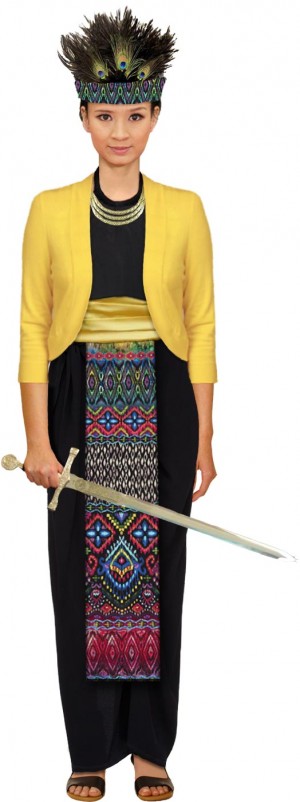 1. Short curved-neck cardigan in yellow or short straight cardigan in mustard yellow. A cropped sweater or jacket is a super easy substitute for the ancient short jacket. We chose yellow since that’s the traditional color associated with the Trung Sisters. If you can find a jacket that’s made of plain woven cotton, not knitted, that would be even better.
1. Short curved-neck cardigan in yellow or short straight cardigan in mustard yellow. A cropped sweater or jacket is a super easy substitute for the ancient short jacket. We chose yellow since that’s the traditional color associated with the Trung Sisters. If you can find a jacket that’s made of plain woven cotton, not knitted, that would be even better.
2. Black halter top. Another convenient substitute. The ancient Vietnamese halter top, or yem, was just a square of fabric with strings to tie it around the neck.
3. Black sarong to wear as a wrap skirt.
4. Front skirt panel: Michael Miller Silk Road Stripe Multi fabric stiffened with double-sided fusible stabilizer. We’re using an ikat pattern fabric for the front decorative panel, since ikat is the pre-Chinese form of pattern weaving in Southeast Asia. One yard of the Mike Miller Silk Road Stripe will be plenty. Get a pack of double-sided fusible stabilizer and cut a piece the width and length you want your panel to be—perhaps 9 inches by 36 inches. Then wrap it with the stripe fabric and iron in place. Easy! To wear the panel, just fold the top edge over a long piece of string and tie it around your waist. The yellow sash (next) will cover up the string.
5. Yellow satin sash. Wrap this around your waist a couple of times after you’ve strapped on your front panel rig.
6. Feathered headdress. Ancient bronze drums recovered from the Dong Son culture in Vietnam (1000 BCE to 200 CE) show people wearing feathered headdresses. Some of those same drums are decorated with images of stylized peacock feathers, so that’s what we decided to use for the headdress. You’ll need:
- Shirt cardboard or poster board
- Michael Miller Silk Road Stripe Multi fabric (left over from making front skirt panel)
- One yard of black hackle feather trim, 6 inches
- One package of peacock eye feathers, 10-12 inches
Cut a piece of shirt cardboard or poster board that’s about 3 inches wide and 24 inches long. Roll it into a crown shape with about one inch on each end overlapping; you can size it on your head to get the right fit. (Average head circumference is 21 or 22 inches.) Once you have the size right, unroll the cardboard again and lay it flat to do the decorating.
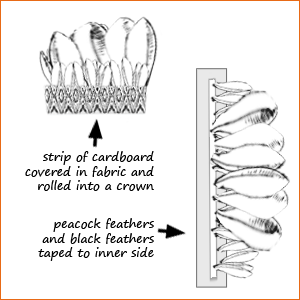 First cover your cardboard crown with some of the Silk Road Stripe fabric you have left over from making the front skirt panel—just glue or tape it on. Now tape or glue the feathers to the back side, which will be the inner side of the crown. Start with a length of the strung black feathers and tape or glue it in place. Add some peacock feathers on top of that. If you need more fullness, add another length of black feathers on top of the peacock feathers. Once you’re finished taping/gluing feathers, you can paste another strip of fabric on top of it all to cover up the messiness and help hold the feathers firmly in place.
First cover your cardboard crown with some of the Silk Road Stripe fabric you have left over from making the front skirt panel—just glue or tape it on. Now tape or glue the feathers to the back side, which will be the inner side of the crown. Start with a length of the strung black feathers and tape or glue it in place. Add some peacock feathers on top of that. If you need more fullness, add another length of black feathers on top of the peacock feathers. Once you’re finished taping/gluing feathers, you can paste another strip of fabric on top of it all to cover up the messiness and help hold the feathers firmly in place.
To wear the crown, roll it up and and fasten the two overlapping ends in place. You can use tape, glue, staples, or even binder clips to hold it together.
 Jewelry: A metal bib necklace or collar is the closest modern equivalent to the ancient style. This bronze triple-tier necklace (shown at right) is pretty much perfect, but any kind of metal bib/collar will do. You can also wear big brass or bronze hoop earrings, cuff bracelets, bangles, and anklets.
Jewelry: A metal bib necklace or collar is the closest modern equivalent to the ancient style. This bronze triple-tier necklace (shown at right) is pretty much perfect, but any kind of metal bib/collar will do. You can also wear big brass or bronze hoop earrings, cuff bracelets, bangles, and anklets.
Shoes: Most people in ancient Vietnam probably went barefoot. We recommend unobtrusive flat sandals.
Sword: You must have one. Actually, you must have two, since you and the other Trung Sister both need to carry one. The usual thing is to get a tai chi sword, since they’re readily available in a full range of prices. An excellent value is the Extendable Tai Chi Sword, which is 37 inches long, looks great, and is only about 12 bucks:
Related posts: For more information and some background research, see our blog post Finally, the Trung Sisters.
Illustration credits: The four drawings in our main illustration are all taken from youth-market pictorial histories of Vietnam. The image in the upper left corner is from the cover of The Trung Sisters Uprising, issued by the Culture and Information Publishing House. The other three drawings are all from Tre Publishing House’s Vietnam History in Pictures series. The one in the top right corner is from Volume 6 of an edition dated 2012. The two images on the bottom are from Volumes 1 and 2 of an edition dated 2010.
Nzinga (1582-1663) was the queen of Ndongo and Matamba, historical states in what is now Angola. This altogether remarkable woman seized the throne and held it for 40 years, successfully resisting Portuguese colonialism. She also created a crack army, waged war and fomented rebellion, played the European powers off against each other, kept male concubines, and, to cope with nagging doubts about her right to rule, declared herself “officially” a man. What a woman.
 From a costuming standpoint, Nzinga is a fascinating figure: existing watercolors made from life (in the center of our illustration above) show her wearing a blend of African and European styles. Her crown, for example, she had especially made to match European models, but she also wore the leopard skins of Mbundu royalty. Her clothing was imported silk, which she had made up by her own dressmakers into ruffled skirts and cloaks. Her jewelry included pearls—a favorite with contemporary European monarchs—as well as African cowrie shells and beads. The pieces we suggest, from left to right:
From a costuming standpoint, Nzinga is a fascinating figure: existing watercolors made from life (in the center of our illustration above) show her wearing a blend of African and European styles. Her crown, for example, she had especially made to match European models, but she also wore the leopard skins of Mbundu royalty. Her clothing was imported silk, which she had made up by her own dressmakers into ruffled skirts and cloaks. Her jewelry included pearls—a favorite with contemporary European monarchs—as well as African cowrie shells and beads. The pieces we suggest, from left to right:
1. Vintage ruffled silk skirt. These gorgeous 6-yard skirts are made from recycled sari silk. As such, they’re probably about as good a match as you’ll find for the kind of skirts Nzinga wore. If that store is out of stock, you can find similar recycled sari skirts here and here.
2. Scallop-pattern sarong in red. In the watercolor sketches it looks like Nzinga is wearing a tie-around top. A sarong will work perfectly, and the pattern on this one evokes the rich look of early 17th century fabrics.
3. Leopard print shawl. This is a generous 72 x 28 inches, plenty long enough to knot around your waist as a sash.
4. Silk shawl in light orange. This beautiful silk pashmina comes in a bunch of different colors; we chose the light orange to coordinate with the rest of the outfit.
5. Costume crown. The shape of this piece is a good match for the crown Nzinga had made for herself; just remove the red fabric. A real metal crown would be nicer, but they’re pricey. Like, a hundred bucks.
6. Jewelry from Firemountain Gems. Firemountain sells to everyone at wholesale prices, so it’s a great place to stock up on jewelry. Clockwise from top left in the composite image below: Red agate necklace (total length 33 inches). Multi-strand wooden bead necklace (total length 30 inches). Freshwater pearl necklace (real pearls, 58-inch continuous loop). Cowrie shell bracelet (we suggest wearing several). Set of carved wooden bracelets (eight bracelets in the package). Faux pearl earrings (2.7 inch drops).
Illustration credits: Giovanni Antonio Cavazzi da Montecuccolo (1621–1678) was a Capuchin missionary who spent time at Nzinga’s court in the 1660s. His watercolor sketches of Nzinga and her courtiers are at the center of our main illustration. The large modern painting to the right is signed “Leo S,” but we have no other information about it. The small Nzinga portrait is from a book cover illustration by Laurie McGaw for African Princess: The Amazing Lives of Africa’s Royal Women.
Maria Makiling is the most widely known and beloved diwata (fairy or nymph) of the Philippines. As the guardian spirit of Mount Makiling, she is depicted as a beautiful young woman in radiant white clothing, surrounded by the natural flora and fauna. Her long black hair is adorned with the fragrant white flowers of the pomelo tree. Maria is shy but gracious and generous, often helping the local people. Stories abound of her giving away baskets of ginger that turn into gold. Other stories tell of her falling in love with mortal men. But she will not tolerate abuse, either of herself or her mountain, and punishes evil-doers by playing tricks on them.
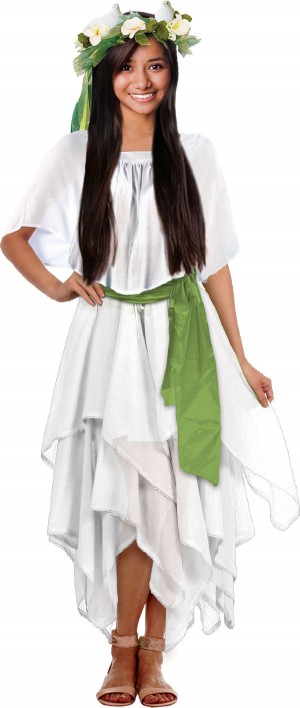 It’s very likely that Maria Makiling is the modern folkloric version of a pre-Christian deity. Diyan Masalanta was the ancient Tagalog goddess of love, whose home was in the forest. When the Spanish arrived, it seems that Diyan Masalanta was renamed Maria Makiling (meaning, in the local parlance, “the woman of Makiling”) and recast as a fairy. And so she lives on, as enchanting as ever.
It’s very likely that Maria Makiling is the modern folkloric version of a pre-Christian deity. Diyan Masalanta was the ancient Tagalog goddess of love, whose home was in the forest. When the Spanish arrived, it seems that Diyan Masalanta was renamed Maria Makiling (meaning, in the local parlance, “the woman of Makiling”) and recast as a fairy. And so she lives on, as enchanting as ever.
For our Maria Makiling costume, we wanted white fairy layers that would float like the mist on Mount Makiling. The pieces we suggest, from left to right:
1. White handkerchief hem dress. This is Sakkas’ “Lady Mary” dress, with bodice lacing and adjustable straps to customize the fit.
2. White square-neck batwing top. Wear this over your dress for floaty layers on your upper half.
3. Apple green satin sash. We wanted some leafy color in our costume, and what’s leafier than apple green?
4. Green enchantress headpiece. Also available here. This delightful wreath not only gives you a fairy look, but also serves as a convenient base for attaching the requisite white flowers (next).
5. Plumeria flower hair clips. In the United States it is difficult to find artificial pomelo flowers, so for our costume we used plumeria blossoms instead. Just clip a few of these right onto your hair wreath.
6. Two 14″ artificial white doves. Maria Makiling is always communing with birds, so why not have a couple of them perch in your hair wreath? You can use hair clips or even binder clips to attach them to the wreath. Check out Factory Direct Crafts for doves in other sizes; they have plenty of smaller ones in various poses.
Main illustration credits: The beautiful painting is Maria Makiling (1994) by Herodion Lovino.
Hatshepsut (ca. 1508-1458 BCE) was an extremely successful pharaoh whose reign was full of accomplishments: important trade missions, gorgeous architecture, a booming economy. But the thing she’s most famous for, at least nowadays, is that she had herself depicted as male on her monuments. There she is, King Hatshepsut, striding across the ancient bas reliefs with her broad shoulders and her beard……it’s a little weird until you understand what’s going on. The role of pharaoh was gendered male in ancient Egypt, and Hatshepsut was just assuming the badges of office. She wasn’t pretending to be personally male, and the texts unmistakably refer to her as female: “she” is the beloved “daughter” of Amun, destined to rule, and so forth. But Egyptian iconography and religion called for the pharaoh to have a male form, and so Hatshepsut had herself depicted with beard, kilt, the whole bit.

That was just for the official portraits, though. In real life Hatshepsut dressed as a woman, probably just adding the regalia that would mark her as pharaoh: a nemes headdress, a crook and flail. We suggest you do the same for the costume. The pieces we suggest, from left to right:
1. White dress from Lotustraders. This is a sleeved caftan-like gown that evokes the drapery styles of Egypt’s Eighteenth Dynasty. The ingenious design has drawstrings at the waist, sleeves, and hemline to give you a perfectly customized fit.
2. Pharaoh’s nemes headdress. This is important, since it’s what makes you Hatshepsut as opposed to, say, Nefertiti or Cleopatra. The nemes was a striped headcloth designed to cover the hair completely. The black-and-gold headdress we used for our costume (which we put together years ago) has now been discontinued by the manufacturer, so the link goes to a blue-and-gold version we found.
3. Crook and flail. Isn’t this awesome? This artist actually makes costume replicas of the Egyptian crook and flail. These were the pharaoh’s special symbols of office, signifying his (or her) role as shepherd of the people and provider of grain.
4. Egyptian collar-style beaded necklace. This necklace is actually from Egypt, so make sure you allow enough time for shipping. That Etsy store offers many other styles as well.
5. Egyptian beaded belt with front panel. From that same Etsy store.
6. Blue scarab ring. As pharaoh, Hatshepsut would have worn a large signet ring. The Egyptian Revival scarab ring we originally used for our costume was an old one-of-a-kind piece of costume jewelry, but you can usually find something similar by hunting on Etsy or eBay.
Makeup: You’ll want to do dramatic eye makeup, with industrial-strength eyeliner and the lines drawn all the way out to your temples. There are a plethora of YouTube videos and instructionals out there. We chose blue eyeshadow to match the accents in the other costume pieces.
Making your own dress: If you would prefer to make your own Egyptian dress, this page has excellent information.
Shoes: We know from King Tut’s tomb that pharaohs had gold thong-style sandals. Something like these Rampage Oliver sandals would work:

Illustration credits: The large central illustration is by Fernando G. Baptista and Amanda Hobbs for National Geographic; it depicts Hatshepsut receiving the riches of Punt. We don’t know the provenance of the top portrait on the right, but the middle one is by Dean Mitchell for Anheuser Busch and the bottom one is by Winifred Brunton.
Before Mulan, there was Fu Hao (ca. 1200 BCE). This Shang Dynasty queen was a remarkable figure: not only was she King Wu Ding’s wife and the mother of his children, but she was also his chief military commander. It seems to us like a strange combination, but Fu Hao was a very successful general, personally leading thousands of troops into battle. Some scholars have even speculated that Fu Hao’s military prowess was the whole reason Wu Ding married her; she may have been a northern princess or warlord who brought horses and chariots into the Shang kingdom as part of the marriage alliance. Fu Hao’s name also pops up repeatedly in the oracle bone inscriptions from that time, showing that she served as a key religious official at court. There’s a lot we don’t understand about the status of women in Bronze Age China, but Fu Hao makes it clear that at least some women could play hugely significant roles in public life.
The basic garment in Shang Dynasty times was a lapped robe with contrasting borders, belted with a broad sash. Nobles also wore full underskirts beneath their robes and had fancy brocade panels hanging down from their sashes in front. As a commanding general, Fu Hao would have also been equipped with armor, a helmet with pheasant feathers, and a ceremonial battle axe with a silk banner. The pieces we suggest, from left to right:
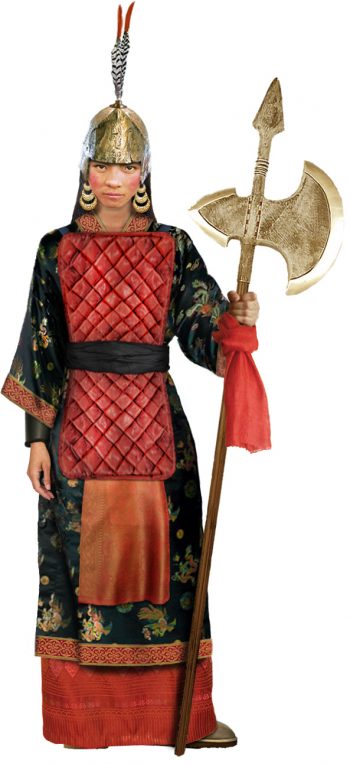 1. Thai silk wrap skirt. We chose this skirt from Thai Craft Warehouse because the pattern is reminiscent of Shang weaving. Not a lot of this will show, though, so you can certainly get away with something more basic.
1. Thai silk wrap skirt. We chose this skirt from Thai Craft Warehouse because the pattern is reminiscent of Shang weaving. Not a lot of this will show, though, so you can certainly get away with something more basic.
2. Black brocade robe with dragon and phoenix motif plus four yards of jacquard ribbon. The robe is probably a bit fancy for the period, but we like it because of the phoenix and dragon. These imperial symbols date right back to Shang times, and in fact, Fu Hao’s tomb contained an exquisite carved jade phoenix (main illustration above). Temporarily attach the jacquard trim with Res-Q tape to create the contrasting borders.
3. Lacquered lamellar armor: bassinet pad plus Rust-Oleum Lacquer Chinese Red spray paint. Fu Hao’s body armor was probably made of small squares of lacquered leather, and if you’re hardcore you’ll of course want to get right to work sewing dozens of little pieces of leather together. But spray painting a piece of quilting is a heck of a lot easier, and good enough for Halloween. (You might want to use a black marker pen to highlight the lines in the quilting to give it more of that lamellar look.) If you make two pads you can have front and back armor, and then pin on a couple of short pieces of ribbon as shoulder straps. Then wrap a black sash (#4) around your waist and cinch it tight.
4. Three sashes: one red paisley, one solid black, and one solid red. The paisley is for the fancy panel that hangs down in front of your robe. Just fold it into a narrow band and suspend it from your waist underneath your armor. The solid black is to cinch around your waist over the armor. The solid red is to tie around your axe (#5) as a banner.
5. Battle axe. The symbol of military authority in Shang times was the yue, a huge bronze battle axe capable of slicing a person in half with a single blow. The shape of the blade on this costume axe isn’t right—the blade on a yue was more rectangular than curved—but the size is great (6 feet long overall). Just improve the color with some spray paint: a coat of Krylon Fusion Blonde Shimmer followed by a coat of Rust-Oleum Aged Brass. Then tie your red sash (#4) around the staff as a banner.
6. General’s helmet with pheasant feathers. Start with a bronze costume helmet. This one is made of flimsy latex, which is good because you need to cut off the nose piece and the cheek pieces. Then get a small brass flange like the kind that’s used in table lamps (available online or in your local hardware store). Glue the flange to the top of the helmet with some seriously powerful adhesive like Gem-Tac. Finally, insert a couple of pheasant feathers into the flange and secure with more glue.
Accessories: It’s the Shang Dynasty, so you gotta wear some hoop earrings. (Fu Hao is even wearing hoops on her statue.) Black leather arm bracers with antique brass rivets will help reinforce your military look.
Poor Freyja! More than any other goddess, she’s been subjected to the strippers-with-swords treatment in contemporary art. But those deformed creatures with giant implants and chainmail bikinis bear little resemblance to the great Freyja, Lady of the Vanir, chief goddess of the Norse pantheon. Freyja is certainly very beautiful—she is, among other things, the goddess of love—but she’s not naked. She wears a fine gown, the magical necklace Brisingamen, and a cloak of falcon feathers that enables her to shapeshift. She’s also a goddess of warriors, and dons helmet and armor for her forays onto the battlefield. (She gets to choose half the slain for her afterlife world of Fólkvangr, while Odin picks the other half to go live with him in Valhalla.) Amber and gold are sacred to her, and all the wild things of nature are her domain. Her preferred mode of travel is in a chariot drawn by two cats, though she occasionally rides through the air on a golden-bristled boar.
Our costume is sort of a fantasy Viking mash-up of these ideas, though regrettably we are unable to include the cat chariot or flying pig. The pieces we suggest, from left to right:
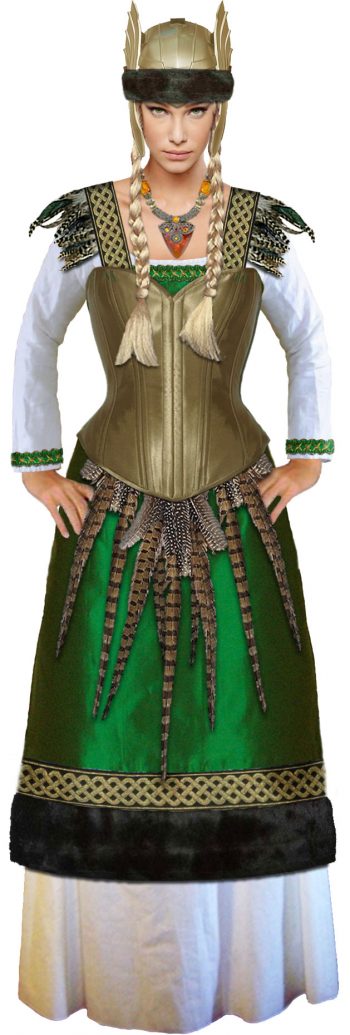 1. Simple medieval chemise. This is for your base layer. You could also just wear a long sleeved white top from your closet and a white maxi skirt, since your mid-section will be completely covered up by the apron dress (#2). You’ll have some kelly green ribbon left over from trimming your apron dress; use it to trim the cuffs of your chemise or top. You can attach it with Res-Q tape.
1. Simple medieval chemise. This is for your base layer. You could also just wear a long sleeved white top from your closet and a white maxi skirt, since your mid-section will be completely covered up by the apron dress (#2). You’ll have some kelly green ribbon left over from trimming your apron dress; use it to trim the cuffs of your chemise or top. You can attach it with Res-Q tape.
2. No-sew Viking “apron dress.” This goes on top of your chemise. It’s nothing more than a yard of fabric wrapped around you like a bath towel, with the straps pinned on. The corset-style breastplate (#3) is what’s going to hold it all together and give you shape, so you don’t have to sew anything. We give you instructions below and a diagram on how to decorate your yard of fabric with faux fur, ribbon, feathers, and amber beads.
3. Breastplate. Make your own breastplate with a longline bra and some metallic spray paint. Seriously, this works. Buy a plain longline bra or recycle an old one, and cover the whole thing in a coat or two of metallic spray paint like Rust-Oleum Aged Brass.
4. Three sprays of artificial pheasant feathers. Tape these inside your breastplate/corset so that they fan out below like a skirt.
5. Valkyrie helmet. We started with an adult viking helmet—which comes disassembled—and left the horns off. We added the wings from a child size Thor helmet that had been painted with a coat of Krylon Fusion Blonde Shimmer. Then we wrapped some black faux fur trim around it (left over from trimming the apron dress—see below) for a fabulous fantasy Viking look. An alternate choice is this beautiful but expensive metal winged helmet from the Village Hat Shop.
6. Faux amber necklace. Freyja’s prize possession is her magnificent necklace Brisingamen, which was forged by dwarves and imbued with all sorts of magical powers. It’s described as being made of fine gold filigree with amber, so you’ll want to wear something pretty elaborate. The piece we suggest has the right look.
Making the “apron dress”: This is by no means a proper Viking apron dress; it’s just a no-sew imitation. All you need is a big rectangle of fabric, 60 inches wide by 36 inches long. Use adhesive tape or glue to attach ribbon trim and faux fur to the fabric. Then wrap it around you like a bath towel and pin in place. The two straps are made from metallic ribbon and feather fringe, and then just pinned on. What you need:
- One yard of 60″ wide green taffeta fabric
- Two yards of 4″ wide black faux fur trim
- Two yards of kelly green metallic ribbon trim
- Three yards of 2″ wide metallic ribbon trim (two yards for the bottom of the dress plus another yard to make the shoulder straps)
- One yard of 6″ feather trim
- Res-Q tape, extra wide (1.5 inches) (this is for attaching the faux fur and ribbon trims to the fabric)
- Safety pins
2012 Costume Contest Winner: Abby Kluska won our very first costume contest wearing our Freyja design! She did a beautiful job with it, and we love the special touches she added to make it her own. Abby used a longline bra for the breastplate, and tells us that she used a few coats of Rust-Oleum Aged Copper for the base plus Rust-Oleum Hammered Gold for accents. Looks great!
Illustration credits: The central image in our main illustration is by Jen Delyth, and depicts Yggdrasil, the cosmic World Tree in Norse mythology. The four rectangular images are all details from larger paintings. Clockwise from top left: 1) detail from a vintage Liebig Company trading card titled Freya, Göttin der Liebe; 2) detail from Freyja and the Necklace (1890) by James Doyle Penrose; 3) detail from the Freyja card in the game Age of Mythology; 4) detail from Valkyrie (1971) by Konstantin Vasiliev.
When Elizabeth I (1535-1603) became queen, people didn’t expect much. “Get yourself married as soon as possible,” she was told, “and lean on your husband for support.” Elizabeth had other ideas. For 45 years she ruled in glorious solitude, steering England with a sure hand and a steely will. She was, quite simply, the greatest monarch in English history.
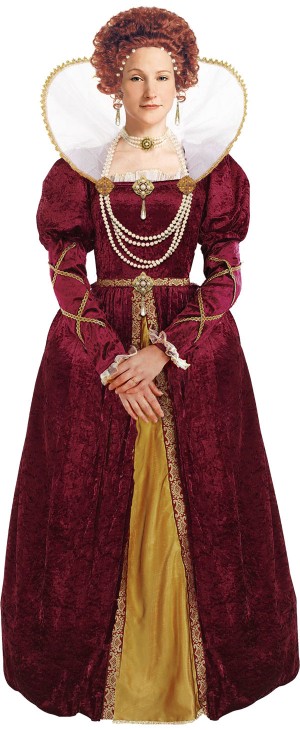 Of course everyone knows how Elizabeth dressed; the problem from the costuming standpoint is just figuring out how to pull off that look without breaking the bank. Our goal was to put together as inexpensive a costume as possible: no pricey reenactment garb here. So we started by ordering a Queen Elizabeth costume from the party store (in both regular and plus sizes). We frankly expected it to be awful, but we were pleasantly surprised. With the addition of some jewelry and the removal of some unfortunate plastic bits, we ended up with an acceptable outfit.
Of course everyone knows how Elizabeth dressed; the problem from the costuming standpoint is just figuring out how to pull off that look without breaking the bank. Our goal was to put together as inexpensive a costume as possible: no pricey reenactment garb here. So we started by ordering a Queen Elizabeth costume from the party store (in both regular and plus sizes). We frankly expected it to be awful, but we were pleasantly surprised. With the addition of some jewelry and the removal of some unfortunate plastic bits, we ended up with an acceptable outfit.
Here are the pieces we used:
1. Queen Elizabeth costume dress, or the almost identical plus-size version. We removed the tacky looking little plastic beads in the front that are supposed to be pearls; we also didn’t use the included headpieces.
2. Wig with pearls. Unless you have a big halo of frizzy red hair, you’ll need a wig to really look like Elizabeth. This one already has pearls attached.
3. Spool of 10 mm pearl beads. These are nice fat pearls; use ropes of them looped around your brooches (next). This particular spool is 22 yards, which is way more than you need, but you can usually get these in the local craft store. At Christmas time you can also find pearl bead strands like this sold as tree garlands.
4. Renaissance-style brooches. We used vintage brooches, but we’re linking to an Etsy search page so you can see examples of what to look for: geometrical shapes and no faceted stones (or very few). Basically you want pearls and polished cabochons.
5. Two pairs of pearl drop earrings. One for your ears, the other to hang from your center bodice brooches.
6. Pearl choker with black center stone. You can actually make your own, as we did, by wearing a close-fitting pearl necklace or choker and fastening a brooch to the center.
Underpinnings: If you want your gown to pouf out at the hips in proper Elizabethan style, you will need a bum roll. The costume comes with a hoop skirt underneath, but the problem is that the hoop is only at the very bottom. You need width at the hips too. Actually, what you really need is a farthingale, but we’re trying to keep the cost down! A bum roll is a good compromise.
And as ever, we recommend a firm undergarment to help give you the rigid torso needed for a period look. Even a longline bra is better than nothing.
The Book of Esther is a subversive feminist tract masquerading as a Bible story. Okay, that probably isn’t true, but by golly, it feels true. Esther, the eponymous heroine, is a courageous young Jewish girl who becomes the wife of the Persian king Ahasuerus (a total schmuck, in more ways than one) and risks her own life to save her people from destruction. The Persian court as depicted in the book—traditionally set in the 5th century BCE—is a dangerous world for a woman, even a queen. Esther’s predecessor, Queen Vashti, is deposed for disobeying the king’s drunken whim; Esther herself risks execution merely by approaching the king unbidden, a crime normally punishable by death. And that’s to say nothing of the king’s creeptastic harem, and his public proclamation that all wives have to obey their husbands. Total schmuck.
King Ahasuerus is also a genocidal maniac, agreeing with his prime minister that it would be a great idea to exterminate all the Jews in the Persian Empire. And that, of course, is what the Book of Esther is really about. The king is on the brink of unleashing the mother of all pogroms when Queen Esther—whose own Jewish background has been a secret until now—steps up in a big way. She fasts and prays for three days, gathers her courage, and then brilliantly maneuvers the king into reversing his decree and saving the Jews. It’s a tremendous victory, commemorated every year in the joyous Feast of Purim.
 Dressing up as Esther for Purim usually involves some variation on a queenly-bridal look, with a long dress, a crown, and maybe a veil. For our version, we specifically wanted to work in some Persian flavor. After all, she’s the Queen of Persia! We went with a draped fez-style headdress, rich blue and gold colors, and a peacock motif to evoke Persian royalty. The pieces we suggest, from left to right:
Dressing up as Esther for Purim usually involves some variation on a queenly-bridal look, with a long dress, a crown, and maybe a veil. For our version, we specifically wanted to work in some Persian flavor. After all, she’s the Queen of Persia! We went with a draped fez-style headdress, rich blue and gold colors, and a peacock motif to evoke Persian royalty. The pieces we suggest, from left to right:
1. Royal blue poncho top. The upper garment that ancient Persians wore really did look a bit like a poncho, as you can see from the wax figure of Queen Atossa in our main illustration. (Atossa doesn’t appear in the Book of Esther, but she was a real queen in the fifth century BCE. In fact, if Ahasuerus = Xerxes I, as is traditionally assumed, then Atossa would have been Esther’s mother-in-law.) An even more flowy poncho top is here, though that one is sheer.
2. Long gold skirt. This is a belly dance skirt, very full and swirly.
3. Five yards of royal blue china silk lining fabric. You don’t need to do anything with this fabric except drape it around you dramatically. Start by pinning the fabric to the top of your fez so that about five feet of it is hanging down on your left side, and the rest of it (about ten feet) is hanging down on your right side. Pull the long end of the fabric up under your right arm in a big loop and pin it on your right shoulder. Then drape another big loop in front of you at waist level, and pin the fabric to your left shoulder. Let the rest hang down on your left side. Use additional safety pins to secure your drapery at your shoulders and other key spots.
4. Purple fez dressed up with ribbons and fringe. We give you instructions below on how to transform a basic fez into a splendiferous crown in peacock colors. You can also just wear a plain fez, if crafting isn’t your thing.
5. Jewelry: a gold-tone cuff bracelet, a blue and gold bead necklace, a gold ball chain necklace, and gold disc earrings. Hang the earrings from the fez for some of that side-tassel action; just hook them onto the sequin trim. To position the necklaces exactly where you want, pin the ends to your blouse rather than connecting them in the back.
6. Peacock feather fan. Perfect for the Queen of Persia.
Turning your fez into a crown: All you need to do is stick on some fancy ribbon, stretch sequins, and fringe. Here’s the ingredient list:
- Purple fez
- One yard of blue brush fringe
- One yard of metallic paisley ribbon
- Two yards of gold stretch sequin trim, cut into two pieces
- Glue or double-sided tape
Remove the tassel from the fez or at least pin it out of the way. Wrap the blue fringe around the lower edge of the fez (you’ll actually need about 22 inches, not a full yard), and tape or glue it in place. Glue the metallic paisley ribbon on next, about three-quarters of an inch above the fringe. Add the two rows of sequins last, since they’re kind of bumpy and can overlap the other trims.
Main illustration credits: The large background image is a mural depicting Esther before Ahasuerus; it’s from St. Bartholomew’s Church in Oppenheim. The image labeled “Queen Esther & Mordecai” is by the mosaic artist Lilian Broca, and depicts the moment when Esther learns from her uncle Mordecai that the king has authorized the murder of the Jews. (By all means visit Ms. Broca’s website at the link; the woman is a genius. You can also buy her book about the Esther series: The Hidden and the Revealed: The Queen Esther Mosaics of Lilian Broca.) The portrait labeled “Queen Vashti” is from the 1999 movie Esther, with actress Ornella Muti in costume as Esther’s unfortunate predecessor. The “Queen Atossa” image is from the Nirupars website, and shows the wax figure of Atossa on display at the Pars Museum in Shiraz.
Eleanor of Aquitaine (1122-1204) was the greatest lady of medieval Europe. In her own right she was Duchess of Aquitaine and Countess of Poitiers, ruling over a large chunk of what is now France. By marriage she was also Queen of France, at least for the 15 years of her union with Louis VII; a high point was when she rode at the head of the Second Crusade with her ladies decked out as Amazons. After divorcing Louis she married Henry II, thus becoming Queen of England—the only woman in history to wear the crown of both countries. In her spare time she sponsored the greatest literary revival of the High Middle Ages; she also masterminded a military rebellion against Henry that landed her in prison for 16 years. She was freed after Henry’s death, and went on to rule England as regent for her son King Richard (who was off on the Third Crusade) and as the power-behind-the-throne for her son King John (who was a doofus).
Eleanor was renowned in her day as a beauty and a fashion plate, but the only real likeness we have of her is the tomb effigy at Fontevrault (see our main illustration above). It was the Middle Ages, after all; even kings and queens weren’t in the habit of having their portraits painted. In fact, nobody even recorded what color Eleanor’s eyes and hair were. So when most of us picture Eleanor of Aquitaine, we’re really thinking of Hollywood: Kate Hepburn in The Lion in Winter, Glenn Close in the remake of the same, Eileen Atkins in Robin Hood. Our costume is a nod to those memorable movie costumes, but using super-easy modern garments. It won’t win you any authenticity awards for historical recreation, but you’ll look marvelous. The pieces we suggest, from left to right:
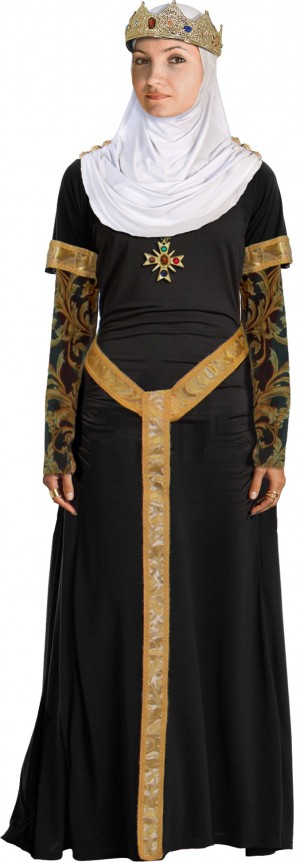 1. T-shirt maxi dress. We chose this maxi dress because it has a flared skirt with princess seams, which gives it the right shape for Eleanor’s period. Any color is okay as long as it’s not some bright modern shade; we went with black because it’s easy and looks great. The fashionable gown in Eleanor’s day was the bliaut, which was laced at the sides. To get that side-lacing effect with this maxi dress, first do a fitting by putting the dress on inside out. Use safety pins along the sides to scrunch it to your body. The material is stretchy enough that you’ll be able to leave the safety pins in place and still pull the dress off and then put it back on right side out.
1. T-shirt maxi dress. We chose this maxi dress because it has a flared skirt with princess seams, which gives it the right shape for Eleanor’s period. Any color is okay as long as it’s not some bright modern shade; we went with black because it’s easy and looks great. The fashionable gown in Eleanor’s day was the bliaut, which was laced at the sides. To get that side-lacing effect with this maxi dress, first do a fitting by putting the dress on inside out. Use safety pins along the sides to scrunch it to your body. The material is stretchy enough that you’ll be able to leave the safety pins in place and still pull the dress off and then put it back on right side out.
2. Wide jacquard ribbon trim. You’ll need about 3 yards for your girdle (belt) and another yard to trim your sleeves. We used a basic gold, but there are a million different patterns to choose from. For the girdle, just wrap the ribbon around your hips, fold one end over the other in front, and let the long end(s) hang down the front of your skirt. Use some Res-Q tape or other double-sided tape to keep it all in position once you get it situated. For the sleeves, just wrap a piece of ribbon trim around the bottom edge of each sleeve and hold in place with Res-Q tape.
3. Long sleeve print top. We bought this particular top off eBay; you just need one with a pattern that doesn’t look too modern. And in fact you don’t even need the whole top; you just need the sleeves. Wear it (or the sleeves) under your maxi dress for that layered medieval look. If you can’t find a suitable print top, a gold blouse would also work. One of the few specific things we know about Eleanor’s wardrobe is that she liked to wear cloth woven with gold threads.
4. One-piece hijab with fancy trim. The white nun-like thing that medieval ladies wore is called a wimple. You can try draping your own or buy a reenactment version, but for an inexpensive and stress-free alternative, we recommend a modern one-piece hijab. We bought this particular one off of eBay, and it’s made of a very stretchy jersey. You just pop it over your head and you’re good to go. You can find similar ones on eBay, Amazon, or any place that sells hijabs.
5. Gold crown. This is a good, substantial piece, with nice cabochon jewels and figured gold detailing.
6. Medieval style necklace. Eleanor of Aquitaine was the richest woman in Europe and known for her love of jewels, so bling is good. Just look for medieval type pieces: cabochon jewels (they didn’t have faceted gemstones back then), bold shapes like the quatrefoil, that sort of thing. We found this piece on eBay.






